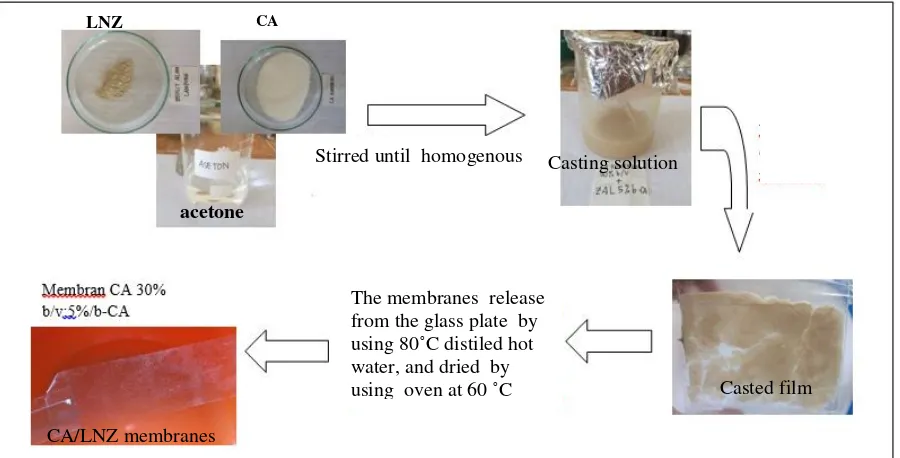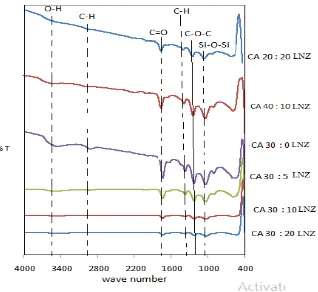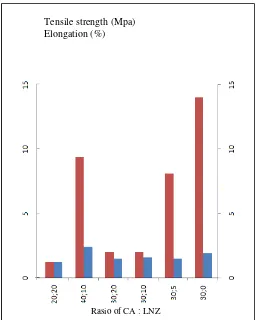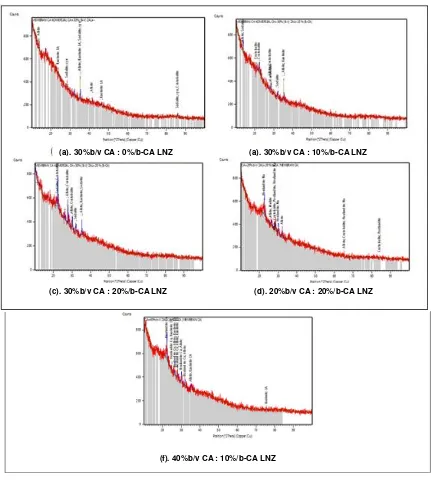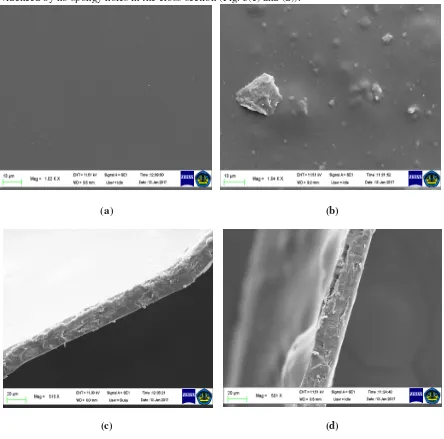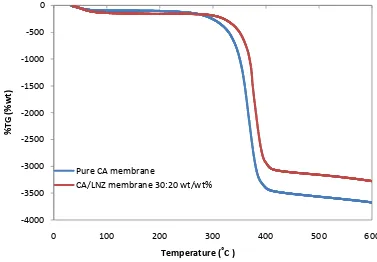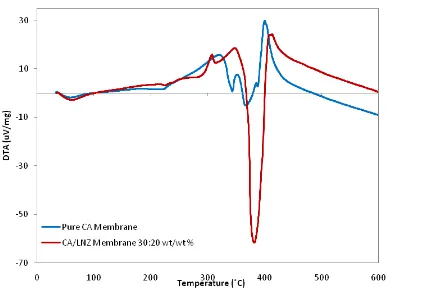Synthesis and Characterization of Cellulose Acetate
Membrane Modified with Lampung Natural Zeolite (Ca/LNZ)
D.A. Iryani1,4*, A.W. Cindradewi1, S. Br. Ginting1, E. Ernawati2, U. Hasanudin3,4
1
Department of Chemical Engineering, Engineering Faculty, University of Lampung 2
Departement of Chemistry, Mathematics and Science Faculty, University of Padjajaran 4
Departement of Agroindustrial Technology, Agriculture Faculty, University of Lampung 5
Research and Development Center for Tropical Biomass, University of Lampung
*Corresponding Author: [email protected]
Abstract. The hybrid membranes for pervaporation of ethanol-water mixture were prepared by filled Lampung natural zeolite (LNZ) into cellulose acetate (CA) casting solution in the varied ratio of CA:LNZ (30:0, 30:5, 30:10, 30: 20, 20:20 and 40:10) wt%. The effect of zeolite addition on the resulting membranes were characterized by using Fourier transform infrared spectroscopy (FTIR), thermogravimetric analysis (TGA) and scanning electron microscope (SEM) and X-ray-diffraction (XRD) analysis, which aims to observe the crystallinity, morphology, and thermal stability of hybrid membrane. The results show that the interaction between the LNZ particles and CA were making the thermal stability, crystallinity, and hydrophilicity of the hybrid membrane improved compared with pure CA membrane.
Keywords : Celullose acetate membrane, Hybrid membrane, Pervaporation membrane, Lampung natural zeolite.
Introduction
The technological developments of membrane separation process in the industrial world are already widespread and widely applied in industries including chemicals [1], bio-ethanol [2], water purification [3,4], metals [5], food [6], gas purification [7,8] and so on. Separation process using membrane-based process has several advantages compared to other conventional separation methods such as distillation and extraction because it is more simple, environmental friendly and low energy requirement [9, 8, 10].
Two type of membrane such as organophilic membranes can be used for recovery of bioethanol from a fermentation broth, while hydrophilic membranes usually apply to dehydration of ethanol near to azeotrope point in a hybrid distillation-pervaporation process [2]. Hydrophilic membranes are often used on pervaporation of ethanol-water. Hydrophilic membranes consist of three types, i.e: (1) polymeric membranes which are based on organic polymer chains that are cross-linked together, (2) inorganic membranes, fabricated from ceramics or zeolites, and (3) composite membranes that are based on an organic polymeric membrane but have inorganic particles dispersed throughout the polymeric structure, these are commonly termed mixed matrix membranes [11].
Generally, polymeric membranes are the most commonly used in the membrane separation processes. Among of polymeric material type, cellulose acetate (CA) is widely applied to separate substances in liquid and gas phase (CA), due to its advantages characteristics such as easy to produce and derived from natural renewable substances, low price, moderate chlorine resistance, good toughness, high biocompatibility and hydrophilicity [1,4,8, 9, 10, 13]. However, CA membrane is not suitable for more aggressive cleaning as it has easily oxidized and low chemical resistance and mechanical strength [1, 9, 13]. Thus, a special treatment is required to improve CA performance by adding nonporous inorganic additives such as alumina, silica, and titania as fillers into CA membrane in order to correct its deficiency properties in accordance with the type of membrane that will be in production [1, 8, 9,17 ]. The presence of inorganic material able to improve mechanical stability, increasing fouling resistance ability, surface porosity, permeability properties and membrane selectivity in separation processes [4, 14, 15].
Various types of porous inorganic fillers such as zeolites and carbon molecular sieves also have been used in mixed matrix membranes. Several researchers have been investigated the effect of the addition of a porous inorganic filler such as zeolite and carbon molecular sieves into organic polymer [16-18]. Ling et al. (2008) had studied the pervaporation separation of ethanol-water mixture using PVA zeolite-clay membranes to investigate the effect of ethanol feed concentration (10%, 30%, 50%, 70% dan 90%) and operation temperature (30, 40, 50, 60, and 70 oC). The investigation shows that incorporation of zeolite into matrix membrane able to increase the selectivity in accordance with the increases of ethanol concentration and operating temperature. However, on the contrary, the absorption (flux) of the membrane is decrease. The other research conducted by Ma et al. (2009), prepared the HZSM5-filled cellulose acetate (CA) membranes by incorporating the HZSM5 into CA for pervaporation separation of methanol/methyl tertiary butyl ether (MTBE) mixtures. Their study found that the permeation flux increased while the separation factor decreased with increasing the amount of methanol in the feed, when operating temperature of pervaporation increase from 298K to 323 K.
A search of the literature reveals that zeolite synthetic are widely used as a filler of polymeric membranes in the view of their better performances. While, to our knowledge, only one study [19] reported the natural zeolite used as a filler of polymeric membrane. The natural zeolites clinoptilolite has been used mainly as the silica source. The use of natural zeolite as an polymeric membrane filler has gained great interest due to its large deposits and it has some promising benefits since they are lower in cost.
transform-infrared, scanning electron microscope, thermogravimetric analysis, universal testing machine and X-ray diffraction. Meanwhile, the membranes pervaporation performance already discussed in our previous paper [20].
2. Materials and Methods
2.1 Materials
The commercial grade of cellulose acetate (Sigma Aldrich, USA) with acetyl content of 39 - 41 %wt and Mw 30,000 was used as the matrix polymer membrane. Lampung natural zeolite (LNZ) (200 mesh) which purchased from CV. Minatama, Lampung, Indonesia was used as a filler. Acetone (J.T baker, USA) was used as solvent to dissolve cellulose acetate.
2.2 Fabrication of hybrid membranes
The hybride membranes were prepared following the procedure as published in [20]. CA was dissolved in 100 ml of acetone and stirred until homegeneous. Thereafter, a calculated amounts of LNZ were added into CA solutions to making the various ratios of CA/LNZ: 30 %wt/v : 0 %/w-CA; 30 %wt/v : 5 %/wt-CA; 30 %wt/v : 10 %/w-CA; 30 %wt/v : 20%/wt-CA; 20 %wt/v: 20 %/wt-CA. The resulting of CA/LNZ solutions in various ratios were stirred for 24h, and it were set aside for 2 hours to remove the air bubbles in the mixtures. The casting solutions were casted on a glass plate and placed in the air for 20 seconds to evaporate all the solvent. The cast films were subsequently immersed in the ice water for 20 min to complete the phase separation process. Further, the membranes were heat-treated in hot distilled water (80°C) to separate the membranes from the glass surface. Finally, the hybrid membranes were placed in an oven at 60 °C for 2 hours. The series of the fabrication of membrane experiments are shown in Figure 1.
Figure 1. Schematic procedure of fabrication of pure and hybrid membranes
The Fourier-transform infrared spectroscopy (FT-IR) spectra of the samples were recorded in the
400-4,000 cm−1 range using 100 Perkin Elmer, MID IR spectrometer.
2.3.2 X-ray Diffraction (XRD)
XRD analysis was carried out by using XRD instrument PAN analytical X’pert3 pro. The analysis used Cu k-α radiation (X = 1,54.[Ȧ]) monochromatic, with tube voltage 40 kv and 30 mA tube current. The Diffraction pattern be measured at range 2Ɵ 0-100o .
2.3.2 Mechanical Stability
The analysis of mechanical strength of the membrane CA and CA/LNZ were carried out at room temperature by using a Universal Testing Machine (UTM) Instron. The membrane was cut to a length of 95 mm and a width of 20 mm. The sample then clamped with two aluminium clamps. One clamp is connected to the base of the lowest of the UTM and another brace in connecting with the force sensor to determine the amount of force exerted. The equation for tensile strength and percentage of elongation are shown in the Equation (1 and 2). The schematic of mechanical stability test are shown in Figure 2.
Figure 2
The schematic of mechanical stability test
σ = 𝐹𝐴 (1)
% ɛ = ∆𝐿𝑃x100% (2) Where :
σ = Tensile Strength (Mpa) ɛ = Elongation (%)
F = load at break(KgF) ΔL = length differences (mm) A = cross-sectional area (mm2) P = initial length (mm)
2.3.3 Scanning Electron Microscopy (SEM)
The top surface and cross sectional morphology of the CA and CA/LNZ membranes in the different ratios were studied using scanning electron microscopy (ZEISS EVO MA 10). All of the sample specimens were coated with a thin layer of gold to prevent charging
2.3.4 DTA/TGA
under oxygen-free condition (nitrogen atmosphere). Nitrogen flow was 20 ml/min in order to remove all corrosive gas involved in the degradation.
3. Result and Discussion
FT-IR (Fourier Transformed Infra-Red)
The FTIR spectra analysis results of membranes in varied compositions of CA/LNZ were shown on Figure 3. All of the peaks obtained from FTIR instrument has been confirmed by some of the literature data [1, 8, 21]. In the spectrum of pure CA membrane, the peak located at 3453 cm-1 is associated to the stretching vibration of hydroxyl group (-OH). The peak of the C = O bond appeared around wave number about 1640 cm-1 and 1736 cm-1 assigned to the presence of an acetyl group. The spectra around the wave number 2926 cm -1 and 1371 cm-1 shows the presence of C-H bond. Peak observed at wave number 1225 cm-1 asigned the C-O-C which also described the presence of an acetyl group.
In the spectrum of CA/LNZ membrane, it shows that the addition of LNZ into the CA matrix affects on shifting of –OH, C=O and C-H bond. The intensity of the band at around 3453cm-1, 1640 cm-1 and, 1225 cm-1 assigned in the bending vibration due to the presence of silica Si-O-Si from LNZ. This result shows that the hydrophilic nature of the membrane increases. The stretching vibrations also occurs on the cluster C-H, C = O and C-O-C which is caused by the interaction between CA and LNZ This results confirmed that there are exist the interaction between CA and LNZ. This results confirmed that the membrane has been homogenized.
The mechanical stability of the membranes were evaluated its tensile properties, i.e., tensile strength and the elongation at break. It is observed that the filled membranes show much lower tensile strength than the pure of CA membrane. In spite of elongation properties, the filled membranes show decrease marginally with an increase of the filler.
The membranes which have good mechanical strength must have the value of percentage elongation
and balanced tensile strength. A very high tensile strength without much elongation causes the rigidity
of the membranes while the high elongation makes the membrane soft [2]. The results of mechanical stability of membranes test shown that the membrane in ratio of CA/LNZ 20: 20, 20:10 and 20:30 indicate the good balance of tensile strength and percentage of elongation. This results explained that the presence of LNZ as a filler into matrix membrane were able to improve the mechanical performance of CA membrane. Thus, the modified membranes can be suitable used for pervaporation process without any mechanical failure.
X-Ray Diffraction (XRD)
The XRD analysis showed the characteristics of the membrane structure, properties of amorphous or crystalalyne of pure CA and CA/LNZ membranes in varied ratios. The diffraction patterns of pure CA, CA/LNZ with different LNZ concentrations are shown in Fig. 6. It can be seen that the XRD pattern of pure CA shows like all other natural polymers was partial crystalline nature [7]. The XRD patterns of CA/LNZ with low LNZ concentrations in presence were similar patterns with pure CA membrane. However, when high concentration of LNZ are added to CA matrix membranes, the
Figure 4. Results of Mechanical Stability Analysis ( tensile strength vs elongation break). Tensile strength (Mpa)
Elongation (%)
intensity of XRD spectra 2Ɵ were increased. It was observed that the characteristic peak of CA/LNZ in ratio of 30:20 and 20:20 the LNZ particles located at 23.07° .This results was indicated that the addition of LNZ into CA matrix membrane was influenced the crystallinity of membrane and improved the mechanical properties of the membrane due to interaction between CA and LNZ.
Figure 5 X-ray diffraction patterns of pure CA, and CA/LNZ membranes in varied ratio
Scanning Electron Microscopy (SEM)
The scanning electron micrograph (SEM) characterizations of CA pure and hybrid CA/LNZ membranes were shown in Figure 5. The morphologies of pure CA and CA filled with LNZ are
(f). 40%b/v CA : 10%/b-CA LNZ
(c). 30%b/v CA : 20%/b-CA LNZ (d). 20%b/v CA : 20%/b-CA LNZ
shown in Fig. 5(a) indicates the smooth surface of pure CAmembrane, and Fig. 5(b) shows that the top surface of hybrid membranes. On the surface of pure membrane, it was observed that a dense featureless morphology. Dissimilar with the pure of CA membrane, there were many protrusions on the surface of the hybrid C/LNZ membrane, which consisted of particles of LNZ or their aggregates. The LNZ filled into the matrix Ca membrane was not change the properties of denser membrane, it is evidenced by no spongy holes in the cross-section (Fig. 5(c) and (d)).
(a) (b)
(c) (d)
Figure 6. Morphology of pure CA membrane and CA/LNZ Membrane: (a) surface of pure CA membrane; (c) surface of CA membrane filled with LNZ (30:20); (c) cross-section of pure CA membrane; (d) cross-section of membrane filled with filled with LNZ (30:20).
Thermal Analysis (DTA/TGA)
The thermal stabilities and degradation behavior of pure membrane CA and CA/LNZ were evaluated by TGA/DTA analysis instrument under nitrogen atmosphere. The TGA/DTA analysis was restricted to samples with a variation of 30% w/v: 0% w-CA and 30% w/v: 20% w-CA. Figure 7 and 8 shows that the degradation of all the CA and hybrid membranes occurs in three stages. The first stage, from
the room temperature 30-160 ˚C, represents the evaporation of water or volatile matter. The second
stage, at 240-320˚C, represents the main thermal degradation of the cellulose acetate chains. The third
step, up to 320-400 ˚C, shows degradation products into ash. At the temperature of around 366oC
membrane completely degraded. In the other hand, membranes CA/LNZ degradation firts stage occurs
at the temperature of 30-110oC represent the evaporation of water or volatile content in the membrane
evaporation CA. The second stage, at the temperature of 240-350 oC decomposition of cellulose
acetate occured, and the last stage around the temperature of 350oC to 420oC the membrane degraded
into ash. At the temperature around of 381oC membrane already started to decompose. Based on these
results, it can be concluded that the addition of LNZ able to improve the thermal stability and retard the thermal degradation of hybrid membranes; this result was similar with previous reports [1,7,17].
Figure 7. Comparisson result of thermogram of membrane CA and CA/LNZ
Figure 8. The DTA analysis result of Pure CA and hybrid CA/LNZ membranes
4. Conclusions
CA/LNZ hybrid membranes were prepared via phase inversion by dispersing the Lampung natural zeolite particle into the CA casting solution. The addition of LNZ into the CA casting solution improved the membrane properties. The conclusions can be listed as follows:
1. It was possible to produce membranes of cellulose acetate hybrid membrane by using natural zeolite. The addition of natural zeolite (LNZ) improve the performance better than pure CA membrane and it is found to be inexpensive and easy to prepare.
2. SEM images show that the LNZ filled into the matrix Ca membrane was not change the properties of denser membrane.
3. The results from mechanical stability test, XRD, and TGA/DTA analysis shows that by increasing the addition of LNZ particles in the casting solution influenced the crystallinity of membrane and improved the mechanical and thermal stability properties of the membrane due to interaction between CA and LNZ.
4. This study may provide useful information to further develop some inexpensive pervaporation membrane for used in separation and dehydration of ethanol-water in industrial.
5. Acknowledgement
6. References
[1] Ma X, Hu C, Guo R, Fang X, Wu H, Jiang Z 2012 Preparation of cellulose acetate/zeolite composite fiber and its adsorption behavior for heavy metal ions in aqueous solution Chemical Engineering Journal 209 325–333
[2] Samanta H S, Ray S K 2014 Separation of ethanol from water by pervaporation using mixed matrix copolymer membranes. Separation and Purification Technology
http://dx.doi.org/10.1016/j.seppur. 2015.03.006
[3] Le N L and Suzana P N 2016 Materials and membrane technologies for water and energy sustainability Sustainable Materials and Technologies 7 1–28
[4] Arthanareeswaran G, Sriyamuna D, Raajenthiren M 2008 Effect of silica particles on cellulose acetate blend ultrafiltration membrans: Part I Separation and Purification Technology 64 38–47 [5] Ji F, Li C, Tang B, Xu J, Lu G, Liu P 2012 Preparation of cellulose acetate/zeolite composite
fiber and its adsorption behavior for heavy metal ions in aqueous solution Chemical Engineering Journal 209 325–333
[6] Guleca H A, Topaclib A, Topaclib C, Albayraka N, Mutluc M 2010 Modification of cellulose acetate membrane via low-pressure plasma polymerization for sugar separation applications: Part I Membrane development and characterization Journal of Membrane Science 350 310–321 [7] Kamal H, Abd-Elrahim F M, Lotfy S 2014 Characterization and some properties of cellulose
acetate-co-polyethylenen oxide blends prepared by the use of gamma irradiation Journal of Radiation Research and Applied 7 146-153
[8] Minhas F T, Farrukh S, Hussain A, Mujahid M 2015 Comparison of silica and novel functionalized silica-based cellulose acetate hybrid membrans in gas permeation study J Polym Res. 22(63) 2-13
[9] Abedini R, Mousavi S M, Aminzadeh R 2011 A novel cellulose acetate (CA) membrane using TiO2 nanoparticles: Preparation, characterization and permeation study Desalination 277 40–45 [10] Saljoughi E, Sadrzadeh M, Mohammadi T 2009 Effect of preparation variables on morphology
and pure water permeation flux through asymmetric cellulose acetate membranes Journal of Membrane Science 326 627–634
[11] Chapman P D, Oliveirab T, Livingstona A G, Li K 2008 Membranes for the dehydration of solvents by pervaporation Journal of Membrane Science 318 5–37
[12] Kanse, N G and Dawande S D 2015 A Review of pervaporation membrane system for the separation of ethanol/water (azeotropic mixture) International Journal Engineering Scince & Research Techology ISSN: 2277-9655 ( http: // www.ijesrt.com)
[13] Kanagaraj P, Neelakandan S, Nagendran A 2014 Preparation,Characterization and Performance of Cellulose Acetate Ultrafiltration Membrane Modified by Charged Surface Modifying Macromolecule Korean Journal of Chemical Engineering 31(6) 1057-1064
[14] Arthanareeswaran G, Thanikaivelan P, Srinivasan K, Mohan D, Rajendran M 2004 Synthesis, Characterization and Thermal Studies on Cellulose Acetate Membranes with Additive European Polymer Journal40 2153–2159
[15] Wang Y, Yang L, Luo G, Dai Y 2009 Preparation of Cellulose Acetate Membrane Filled With Metal Oxide Particles for the Pervaporation Separation of Methanol/Methyl Tert-Butyl Ether Mixtures Chemical Engineering Journal 146 6–10
[16] Dogan H and Hilmioglu N D 2010 Chitosan coated zeolite filled regenerated cellulose membrane for dehydration of ethylene glycol/water mixtures by pervaporation Desalination 258 120–127.
[17] Abedini R, Mousavi S M, Aminzadeh R 2011 A novel cellulose acetate (CA) membrane using TiO2 nanoparticles: Preparation, characterization and permeation study Desalination 277 40–45 [18] Ling L K, Ghazali M, Nawawi M, Sadikin A Z 2008 Pervaporation of Ethanol-Water Mixture
[19] Ji F, Li C, Bo T, Xu J, Lu G, Liu P 2012 Preparation of cellulose acetate/zeolite composite fiber and its adsorption behavior for heavy metal ions in aqueous solution Chemical Engineering Journal 209 325–333
[20] Iryani D A, Wulandari N F., Cindradewi A W, Ginting S, ErnawatiE, Hasanudin, U. 2018 Lampung natural zeolite filled cellulose acetate membrane for pervaporation of ethanol-water mixtures IOP Conference Series: Earth and Environmental Series 141 (012013) 1-8
doi :10.1088/1755-1315/141/1/012013
